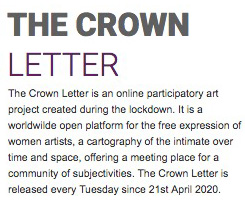THE CROWN LETTER is a participative project initiated on 21 April 2020 by the artist Natacha Nisic.
The Crown Letter began at the onset of the Covid crisis, a time of widespread astonishment and despondency. French artist Natacha Nisic was convinced that there was an urgent need to come up with a global, collective response. Art could not be absent in the face of a catastrophe; it had to breathe and spread its oxygen in times of asphyxia.
With neither resources nor institutional support, Nisic envisaged a website and immediately contacted artist friends from different countries and generations. A collective was soon organized with no leader or editorial line, driven by a common need that barely needs to be explained.
While confinement affected everyone, it was clear to us all that it had a heavier impact on women, including artists. More than ever, they wanted to work and expose themselves in every sense to scrutiny and criticism. Through The Crown Letter, they created a space to express and share what each of them and all of us were going through. They invented an “us” with open borders. Collectively, individualities were not blurred, but rather supported each other. As months went by, the dialogue became deeper.
The Crown Letter is presented as an online exhibition whose works, videos, photos, sculptures, poetry and prose are launched every week. It is a polyphonic manifesto with a tuning fork of the tempest, which over the weeks has become the intimate and collective diary of the pandemic from Mumbaï to Buenos Aires, Glasgow, London, Bucharest, Moscow, and Paris.
The Crown Letter is a modest yet stubborn enterprise. It has passed its first anniversary and continues. It will undoubtedly continue beyond the circumstances that brought it into being. (Paris, Aug. 2021.)
Awards
Fluxus art project 2021 / Hans und Lea Gründig award 2021
THE CROWN LETTER naît en avril 2020, au début de la crise du Covid, alors que la stupeur et l’abattement tétanisent les esprits. L’idée s’impose à l’artiste française Natacha Nisic qu’il faut d’urgence construire une réponse collective et internationale. Par temps de catastrophe, l’art ne peut s’absenter, par temps d’asphyxie, il doit respirer et diffuser son oxygène.
Sans moyens, sans soutien institutionnel, Natacha Nisic imagine un site internet et se tourne aussitôt vers des amies artistes de tout pays et de toute génération. Autour d’elle se constitue très vite un collectif sans chef d’orchestre ni ligne éditoriale, mu par une nécessité commune qu’il est à peine besoin d’expliciter.
Si le confinement s’abat sur tous, chacun sent déjà qu’il pénalise plus lourdement les femmes, y compris les artistes. Plus que jamais, elles veulent travailler et s’exposer dans tous les sens du terme, aux regards comme à la critique. Avec The Crown Letter, elles créent un espace pour exprimer et partager ce qui arrive à chacune et à tous. Elles inventent un « nous » aux contours ouverts. Au sein du collectif, les individualités ne s’effacent pas, elles s’épaulent. Au fil des mois, le dialogue s’approfondit, des œuvres collectives naissent.
The Crown Letter se présente comme une exposition en ligne qui lance chaque semaine une salve d’œuvres nouvelles, vidéos, photos, sculptures, poésies et proses. Elle est un manifeste polyphonique au diapason de la tempête devenu au fil des semaines le journal intime et collectif de l’épidémie de Mumbai à Buenos Aires, de Glasgow, Londres, Bucarest, Moscou… à Paris.
The Crown Letter est une entreprise modeste mais têtue. Elle a passé le cap de son premier anniversaire et continue. Elle continuera sans doute par-delà les circonstances qui l’ont fait naître.
Maithili Bavkar, Mumbai, India – SE Barnet, Suffolk , G.-B. – Kate Blacker, Normandy – Alisa Berger, Düsseldorf – Andrea Blum, New York – Anne Brunswic, Paris – Adriana Bustos, Buenos Aires – Pascale Criton, Paris – Michelle Deignan, London – Silvana Deluigi, Buenos Aires – Liza Dimbleby, Glasgow – Anne Dubos, France – Dettie Flynn, Champtoceaux, France – Shani Ha, New York – Julieta Hanono, Paris, Buenos Aires – Claire-Jeanne Jézéquel, Paris – Kyoko Kasuya, Paris – Saviya Lopes, Mumbai – Ruth Maclennan, London – Ana Mendes, from Portugal – Mericarmen Merinos, San Jose Costa Rica – Aurelia Mihai,from Romania to Hamburg – Doriane Molay, Paris – Manuela Morgaine, Paris – Tania Mouraud, Paris – Sarah Naqvi, Mumbai – Natacha Nisic, Paris – Emmanuelle Pellegrini, France – Piyarat Piyapongwiwat, Bangkok – Sudha Padmaya Francis, Kerala, India – Kumjana Novakova, Skopje, Macedonia – Catherine Radosa, from Prague to Paris – Sandra Richard, Paris – Luise Schröder, Leipzig – Esther Shalev-Gerz, Paris – Mika Shigemori, Kyoto – Katja Stuke, Düsseldorf – Catalina Swinburn, Buenos Aires – Chiyoko Szlavnics, Berlin – Ivana Vollaro, Buenos Aires – Jane Watt, Woodbridge – Emma Woffenden, London – Ruth Zylberman, Paris
